STATEMENT OF
POSTMASTER GENERAL AND CHIEF EXECUTIVE OFFICER
MEGAN J. BRENNAN
before the
House Oversight and Government Reform Committee Hearing
“Accomplishing Postal Reform in the 115th Congress –
H.R. 756, the Postal Service Reform Act of 2017”
UNITED STATES HOUSE OF REPRESENTATIVES
Tuesday, February 7, 2017
Good Morning Mr. Chairman, Ranking Member Cummings and Members of the Committee.
I am pleased to represent the 640,000 hard-working and dedicated men and women of the United States Postal Service. These men and women play an integral role in every region, community and neighborhood of our nation, every day.
Thank you, Chairman Chaffetz, Ranking Member Cummings and Members of the Committee, for calling this hearing, to discuss the need for timely and comprehensive postal reform legislation. By law, the United States Postal Service operates as a basic and fundamental service provided to the people by the Government of the United States. We provide the nation with a vital delivery platform that enables American commerce, serves every American business and residential address, and binds the nation together, as it has for more than 240 years.
WHO WE ARE
We currently deliver to more than 156 million delivery points. The 154 billion pieces of mail we deliver annually account for 47 percent of the world’s mail, which we deliver at levels of efficiency and affordability equal to or exceeding any comparable post. The Postal Service is a self-funding entity. We pay for our operations entirely through the sale of postal products and services and do not receive tax revenue to support our business.
Even in an increasingly digital world, the Postal Service remains an essential part of the bedrock infrastructure of the economy. The physical delivery of mail and packages to America’s homes and businesses is the core function of the Postal Service, and this fundamental need of the American people will exist for the foreseeable future.
Our customers place great faith in the ability of the Postal Service to deliver for them, both in the literal delivery of mail and packages, and in the larger sense as an organization that is adapting and changing to better meet America’s evolving delivery needs.
The Postal Service is speeding the pace of innovation, improving our competitive posture by offering new products, and continuing to implement initiatives intended to lower our cost base and stabilize our systemic financial imbalances. And we’re doing so against a backdrop of great change in technology use and consumer habits, and of rapidly rising expectations for delivery services.
During the last decade, we have responded aggressively to the challenges that confronted us. For example, in response to the sharp decline in mail volume, we right-sized our operations, increased workforce flexibility, and established a more affordable, two-tiered wage system. These efforts have resulted in cost savings of approximately $14 billion annually. We also are proud of our achievements in growing our package business, and implementing innovations that have enhanced the value of the mail to better serve our customers.
Despite these achievements, our efforts have not been enough — and cannot be enough — to restore the Postal Service to financial health, absent legislative and regulatory reform. Our debt is at an unsustainable level and while we continue to pursue available management actions to reduce our costs even further, there are limited remaining initiatives within our control that will result in substantial cost savings without threatening our ability to continue to provide prompt, reliable, and efficient postal services. The $5.6 billion net loss for 2016 represented the 10th consecutive annual net loss the Postal Service has incurred. We have reached our borrowing limit and have a cash reserve that is wholly inadequate for an organization of our size and insufficient to meet our future financial obligations.
Our ability to continually change and improve to meet the changing needs of the American economy and society depends upon our ability to operate with a financially sustainable business model. My testimony today describes our current financial situation and demonstrates the urgent need for the legislation introduced (H.R. 756) that would provide the Postal Service with the financial stability to invest in our future and continue to be an engine of growth, to be a strong business partner, to compete for customers with compelling new services and offerings, and to meet the expectations of the American public.
The timing of this hearing is notable. We are now entering the 11th year since the enactment of the Postal Accountability and Enhancement Act of 2006 (PAEA). At the time the PAEA was enacted, we had just finished fiscal year 2006, in which we delivered 213 billion pieces of mail; last year, we delivered 154 billion pieces — a 28 percent decline. Unfortunately, the PAEA did not establish a business model with sufficient flexibility to enable us to effectively respond to this precipitous volume decline.
POSTAL SERVICE FINANCIAL CONDITION
Our business was severely impacted by the Great Recession. First-Class Mail — our most profitable product — declined by 36 percent since 2007 and is expected to continue to decline as a result of divergence to digital communications and the increase in online transactions. Marketing Mail likewise saw a significant volume drop due to a significant reduction in advertising spending caused by the recession. This decline in volume has eroded our financial stability, and reduced our revenue available to help pay for the nationwide retail, processing, transportation and delivery network that we are required to maintain in order to provide universal service.
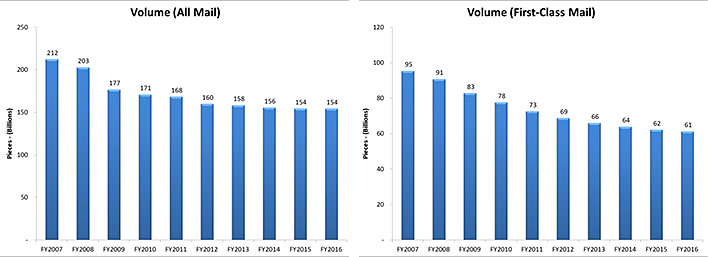
The consequence of this loss of mail volume, along with continued growth in the required delivery points, and unaffordable, legally-mandated payments, has been 10 consecutive years of net losses. In 2012, the Postal Service reached the $15 billion statutory borrowing ceiling and has been forced to default on $33.9 billion in mandated payments for Retiree Health Benefits (RHB). Without these defaults, the deferral of critical capital investments, and aggressive management actions, we would not have been able to pay our employees, our suppliers, or deliver the mail.
Ten Years of Net Losses Despite Innovation and Improved Efficiency
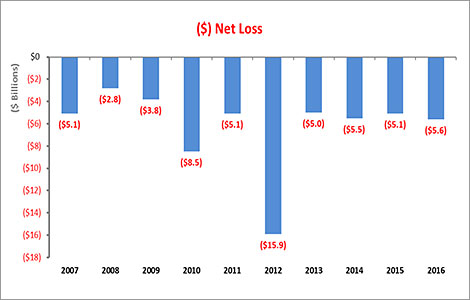
*Note: The 2012 loss was due to legislative deferral of the 2011 $5.5 billion payment for RHB, which made the total payment due for RHB $11.1 billion in 2012.
MANAGEMENT ACTIONS
In response to the dramatic changes in our business environment, we acted to right-size our network and infrastructure within the constraints of our existing business model and current legal obligations. We pursued an aggressive agenda of cost cutting, efficiency improvements, and innovation that resulted in approximately $14 billion in annual savings. We achieved these annual savings by consolidating processing plants and delivery units; modifying retail hours at more than 13,000 Post Offices; reducing the total workforce size by more than 150,000 through attrition; negotiating collective bargaining contracts to control costs and increase workforce flexibility; and through reductions in administrative overhead.
COST CONTROL MEASURES: 9/30/2006 - 9/30/2016
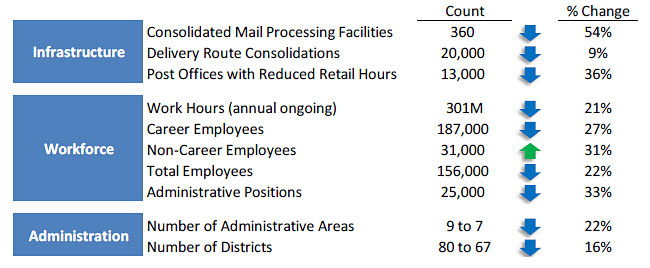
The Postal Service continues to control costs and meet current and future customer needs and market trends. Leveraging available data and enhanced technology, we are improving our diagnostics and reporting tools. Recent targeted capital investment has allowed the organization to process mail and increasing package volume more efficiently.
INNOVATION
As a part of our efforts to adjust to the dynamic marketplace, we are changing and improving to better serve our customers through continued innovation and improved efficiency. We continue to focus on anticipating customer needs and enhancing the value of mail while remaining proactive, flexible and responsive to the marketplace. Focused innovation, such as the integration of marketing mail and digital advertising, is key to sustaining mail volume into the future.
We also continue to innovate by spurring growth in our package business. We are partnering with a number of major U.S. retailers to develop customized delivery solutions to meet their particular business needs. Examples of the solutions we have developed include our Sunday and same-day delivery initiatives, as well as our “ship-from-store” agreements that expedite the delivery of goods from businesses to consumers and improve convenience. These efforts have significantly enhanced the continued double-digit growth in package volume.
Continued innovation in our package business is essential to our ability to meet our universal service obligation to the American people as First-Class Mail continues to decline. These products provide an essential — and growing — level of contribution to help us pay for our institutional costs, and thus help to sustain the network that benefits all mailers.
RECENT FINANCIAL PICTURE
As a result of these innovation and cost reduction initiatives, in the last three years, we grew our package business and stabilized our marketing mail volume — which together with the temporary exigent price increase resulted in increased revenue and generated $3.2 billion of controllable income.
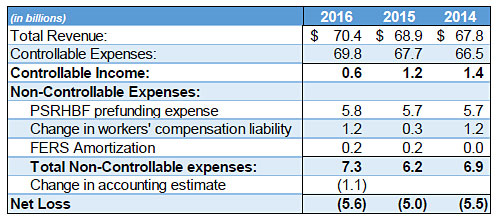
Controllable income is a non-Generally Accepted Accounting Principles (GAAP) measure that excludes the mandated lump-sum RHB prefunding, and non-cash actuarial adjustments to our workers’ compensation and Federal Employees Retirement System (FERS) liabilities over which management has little or no control. Controllable income is more reflective of operating performance than net income, due to the outsized effects of these mandated and uncontrollable expenses. Although our progress in achieving three consecutive years of controllable income has demonstrated the effectiveness of our innovation, marketing and cost-management strategies, when non-controllable expenses are considered, our net losses over the last three years have averaged over $5 billion, driven primarily by our continuing obligation to fund retiree health benefits, which accounted for our entire loss over the last 3 years.
As a result of these net losses, we do not have sufficient cash to meet all of our existing legal obligations, pay down our debt, and maintain a sufficient level of liquidity to ensure continuity of postal operations and meet our universal service obligation. Our cash balance remains insufficient to support an organization with more than $70 billion in annual expenses, and with liabilities that exceed assets by $96 billion, when all post-retirement obligations are included.
Total Liabilities, Including Retirement Obligations Exceed Assets by $90 Billion

- This chart includes all assets and liabilities of pension and post-retirement health benefits obligations.
- Items highlighted in yellow are not shown on our balance sheet and the RHB obligations are valued under actuarial funding basis as of Sept. 30, 2016.
CAPITAL INVESTMENT
In response to the grave financial crisis brought on by the Great Recession and continued electronic diversion of mail, we dramatically slowed our capital-investment activity. This 6-year period of reduced capital investment was a short-term countermeasure to a financially challenging operating environment during which we were at the statutory borrowing limit and had insufficient cash reserves. During this period, capital investments were restricted to those necessary to ensure the health and safety of employees and customers, and those that produced a significant and rapid return on investment.
In 2015 and 2016, the Board of Governors decided it was necessary to increase capital investments to address deferred initiatives and provide critical new equipment and systems required to ensure our continued ability to provide universal service and improve our financial results. These investments include replacing aged administrative, delivery and service vehicle fleets; repairing facilities; sustaining, enhancing or developing new IT systems; ensuring IT and physical security; and procuring, upgrading and maintaining mail and package processing equipment. As the chart below illustrates, we continue to be very judicious in our capitalinvestments, as 2017 projected outlays remain below 2007 levels.

BUSINESS MODEL CHALLENGE
The PAEA did not establish a business model with sufficient flexibility to enable us to effectively respond to ongoing volume declines.
Some of our most significant costs are fixed by law and are outside management’s control. Further, our ability to earn revenue to pay for those costs is constrained by law. This fundamental imbalance is the root of our financial instability, and is primarily influenced by three key factors:
- Universal Service Obligation: We are required to maintain an expansive retail, transportation, processing, and delivery network, so that we can serve every address six days a week. The cost of the network continues to grow as the country adds approximately 1 million delivery addresses each year. Additionally, total mail volume has declined from 213 billion pieces in 2006 to 154 billion pieces last fiscal year, and projections are that mail volume will continue to decline. Simply put, we deliver less mail to more addresses every year.
- Legally mandated costs: The Postal Service is also legally required to participate in U.S. government pension, health, and benefits programs. By law, we have been required to fund RHB using an onerous and unaffordable accelerated prefunding payment schedule, which is unique to the Postal Service. Beginning in 2017, this is replaced by an equally unaffordable system of funding retiree health benefits normal costs and paying down the unfunded liability of the retiree health benefits fund.
- Price cap: We operate under a fixed statutory price cap that applies to the mail products that generate 74 percent of total revenue. Reduced mail volume and the constraints of our statutory price cap means there is less revenue to pay for our required and increasingly expensive network and other costs imposed upon us by law.
UNIVERSAL SERVICE OBLIGATION
The Postal Reorganization Act of 1970 and other provisions of Title 39, United States Code, set the parameters for the Postal Service’s universal service obligation (USO). The dimensions of the USO can be summarized as follows:
- Product scope: Pertains to all postal services, which must be designed to meet public needs.
- Universality: The public must have “ready access to essential postal services,” to the extent “consistent with reasonable economies.” Postal services must be provided “throughout the United States” to, “as nearly as practicable, the entire population of the United States,” explicitly highlighting the need to service “rural areas.” And the Postal Service may not unduly or unreasonably discriminate among mailers.
- Service: According to riders that Congress has consistently inserted into annual appropriations bills, the Postal Service must deliver mail six days per week to most addresses, regardless of whether it makes economic sense to do so. In addition, the Postal Service must prioritize “prompt” and “expeditious” mail delivery. The Postal Service must design its service standards so as to “reasonably assure Postal Service customers delivery reliability, speed and frequency consistent with reasonable rates and best business practices.”
- Price: Certain rates must be uniform across the nation. Some mailers are statutorily entitled to discounted or free rates.
- Accountability: The Postal Regulatory Commission (PRC) is authorized to adjudicate disputes about undue or unreasonable pricing discrimination, improper closing or consolidation of Post Offices, as well as review the Postal Service’s service standards regulations, and certain other matters that bear on the USO. The Postal Service must measure and report publicly about its service performance, which the Commission reviews as part of its annual compliance determination.
Most of these universal service parameters are broad and allow for some discretion on the part of the Postal Service to adjust operations to changing conditions. However, the Postal Service’s discretion is checked by statutory restrictions, the prospects of legal disputes before the PRC or in labor arbitration, oversight by members of Congress, and, the prospect that service reductions could lead to decreased demand from the consuming public.
While some private delivery companies provide competing service with respect to some USPS products, they do not operate under a USO. The USO legally binds us to provide prompt and reliable service to the entire nation at affordable (and in some cases uniform) prices, regardless of cost. In recognition of the burdens imposed by the USO, Congress has historically sought to sustain the USO by guaranteeing the Postal Service certain revenue. The Private Express Statutes require all letters less than 12.5 ounces carried over post routes to be sent through the Postal Service, with various exceptions. Another statute requires all mailable matter placed into mailboxes to bear postage; that statute not only protects postal revenue, but also ensures the privacy, security and efficiency of the mail.
LEGALLY MANDATED COSTS
We are required to participate in U.S. government pension and health benefits programs for employees and retirees, including the Federal Employees Health Benefit (FEHB) program, the Civil Service Retirement System (CSRS), the Federal Employees Retirement System (FERS) and the Federal Employees’ Compensation Act for workers’ compensation (FECA). The PAEA imposed a requirement on the Postal Service to prefund the Postal Service Retiree Health Benefits Fund (PSRHBF) in 2006, on an accelerated basis for 10 years, and on an actuarial basis thereafter.
As noted above, the fixed RHB payment schedule ended last year, and has been replaced with a requirement to make RHB normal cost payments and to begin paying down our unfunded RHB liability. In addition, beginning this fiscal year (FY 2017) we are also obligated to begin amortizing our unfunded liability in CSRS. These obligations are in addition to another sizable existing payment — normal cost payments under FERS and amortization payments on an unfunded FERS liability (we contend that FERS is not underfunded if our liability was more appropriately calculated using postal-specific economic and demographic assumptions, and have therefore requested that the Office of Personnel Management (OPM) reconsider this amortization amount). The table below highlights the average required annual retirement-related payments over the last five years, as well as the average projected annual payments for the next five years.
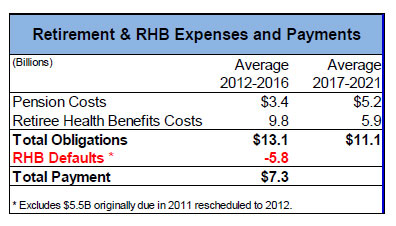
Therefore, we remain subject to very sizable retirement-related payments going forward, on top of our operating expenses and needed increase for critical capital expenditures on items such as information technology infrastructure, processing and delivery infrastructure, and new delivery vehicles.
Absent fundamental legislative and regulatory reform, we continue to face the prospect of defaulting on future retirement-related payments in order to continue paying our employees and suppliers and to provide postal services to the American public. This increases the risk that taxpayers may ultimately be called on to fund these benefits. For instance, a failure to make the actuarially-based RHB payments that begin this year would reduce and eventually exhaust the balance in the PSRHBF.
Therefore, it is clear that continuing to default on our retirement-related funding obligations is not a feasible strategy. Rather, we need a statutory and regulatory structure that allows us to take steps to raise revenue and cut costs in a rational, business-like manner, so that we can fulfill our responsibility of providing universal service in a self-sufficient manner while also covering our post-retirement benefits obligations. This requires two steps: the enactment by Congress of appropriate postal reform legislation, and a favorable outcome of the 10-year pricing system review by the PRC.
PRICE CAP
The fixed statutory price cap is now under review by the PRC, as required by law. This review of the current pricing system is of critical importance. Through this review, the PRC will assess whether the existing system governing market-dominant products is achieving the objectives set forth by Congress. The objectives include requirements that the regulatory system enable the Postal Service to be financially stable and have adequate resources to ensure the continuation of high-quality service. This is consistent with the long-standing policy that the Postal Service provides universal service and meets our other statutory obligations in a self-sufficient and business-like manner. Our ability to fulfill these objectives is hamstrung by the inflexible price cap imposed by the PAEA over products that produce 74 percent of our revenue.
The current price cap limits price increases simply on the basis of household inflation (as measured by the Consumer Price Index), without regard to our specific circumstances, including mail volume trends that have declined precipitously in the last decade and that will continue to decline, and our unaffordable but legally mandated cost structure. That unaffordable cost structure is driven by our obligation to provide universal service and to maintain the network and infrastructure necessary to fulfill that role, as well as by employee benefit and other costs imposed upon us by law.
The PRC began its review proceeding in December 2016 to potentially replace the current system with a suitable regulatory structure. We are preparing our initial comments to the PRC, which will elaborate further on our view that the PRC cannot rationally conclude that the current system is achieving its objectives. We will therefore urge the PRC to replace the current system with a regulatory structure that enables us to effectively respond to the challenges and opportunities presented by a dynamic marketplace.
The current price cap has clearly failed to achieve the objectives. Despite the fact that we have achieved significant cost savings, the restrictions on our business model and the limitations imposed by the cap have contributed to our financially unsustainable position, characterized by chronic net losses, high debt, and a liquidity position that is inadequate, and that would have been catastrophic had we not defaulted on statutorily mandated payments and deferred critical capital investments.
Replacement of the current price cap with an appropriate regulatory structure is ultimately necessary because the current system is unworkable in today’s environment. Congressional action on legislative reform would minimize the size of the price increases needed to cover our costs.
LEGISLATION
Last week, the House Committee on Oversight and Government Reform introduced postal reform legislation containing provisions that we believe have the capability to achieve broad support among stakeholders, including postal management, many in the mailing industry and the postal unions. These provisions reflect the adoption of private sector best practices, consistent with our responsibilities to the public. They include:
- Requiring full Medicare integration for parts A, B, and D for postal retiree health plans.
- Restoring half our exigent price increase for Market-Dominant products.
- Calculating all retirement benefit liabilities using postal-specific salary growth and demographic assumptions.
- Providing some additional product flexibility.
Enactment of these provisions would resolve several significant long-term financial burdens on the organization with potential to generate total savings of $26 billion over five years. Combined with a favorable outcome of the 10-year pricing review by the PRC and continued aggressive management actions, these provisions would restore our financial stability, ensure our ability to meet our universal service obligations, and allow for further innovation, investment, and growth for the Postal Service, and the mailing industry as a whole.
RETIREE HEALTH BENEFITS
Our significant financial losses are due in large part to the legally mandated RHB prefunding requirement. Such a requirement to prefund retiree health care obligations is not imposed on most other federal entities or private-sector businesses that offer retiree health benefits, let alone on an accelerated basis. The Postal Service’s funded level for RHB far exceeds that of civilian federal government entities, state governments, and those private sector companies that offer retiree health benefits at all.
USPS Retirement Health Benefit Funding Compares Favorably to Other Entities
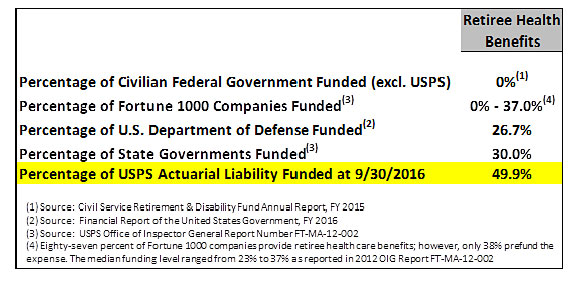
While the statutory accelerated RHB prefunding payments expired Sept. 30, 2016, the current actuarial payments are equally unaffordable because FEHBP benefits are not integrated with Medicare for all postal retirees. Virtually all self-funded private and public-sector organizations that provide retiree health benefits require Medicare integration. The Postal Service and our employees and annuitants pay into Medicare at the same rates as these entities, and should be entitled to the same Medicare benefits. The proposed bill requires OPM to create separately rated postal plans within the FEHBP, beginning with the 2018 contract year, which would be fully integrated with Medicare Parts A, B, and D. These plans would be offered by any existing FEHBP carrier that currently covers at least 1,500 postal employees and annuitants, and other carriers that desire to participate.
Each year, the Postal Service would make a normal cost payment into the RHB fund, except to the extent that such a payment would cause the RHB actuarial liability to be more than 100 percent funded.
Opponents of this provision have argued that it would simply shift cost from the Postal Service to Medicare. While it is true that Medicare costs will increase by approximately one-tenth of 1 percent per year, this provision is actually reversing the cost shifting that currently exists from Medicare to the FEHBP plans, which is presently imposing additional unwarranted costs, on the Postal Service, on our ratepayers, and on our employees. Since 1983, the Postal Service and its employees have been the second largest contributor to Medicare, contributing more than $30 billion during this period. At present, however, 8 percent of annuitants and dependents do not participate in Medicare Part A and 26 percent do not participate in Part B. Appropriately assigning claims costs to Medicare, instead of FEHBP, creates savings for the Postal Service and participants, and effectively resolves the RHB funding issue. Requiring full participation in Medicare by eligible annuitants is a universal practice among nearly all private sector and state and local government employers who provide health benefits to retirees. The Postal Service is simply asking to be treated like any other entity that is required to pay into Medicare and self-fund the benefits they offer to their retirees.
The integration cost of $821 million in FY 2016 would have been just one-tenth of 1 percent (0.1%) of the total annual Medicare payments.
The requirement for all retirees and survivors over age 65 to participate in Medicare Parts A and B — plus the additional Part D savings resulting from establishing an Employer Group Waiver Plan (EGWP) to take advantage of subsidies available for prescription drug benefits within each FEHB plan — would essentially eliminate the Postal Service’s unfunded retiree health benefit liability and reduce expenses by $16.8 billion over 5 years (2018-2022).
MARKET-DOMINANT RATES
The partial restoration of the exigent price surcharge is critical to the Postal Service’s financial health. The PRC-ordered rollback of the surcharge occurred April 10, 2016, and reduced our revenue and net income by approximately $1 billion last year and $2 billion per year going forward, which is an irrational outcome considering the Postal Service’s financial condition.
The price cap that is currently imposed on market-dominant products and services is clearly not enabling the Postal Service to achieve financial stability despite our best efforts to reduce costs. In fact, the current price cap simply will not work since mail volumes have rapidly declined, while many of the costs necessary to meet our universal service obligation are largely fixed and growing. The growth experienced in the past few years in package revenue is not enough to offset the decline in revenue from market-dominant products. The exigent surcharge, combined with aggressive management actions, softened the financial blow that the Postal Service suffered as a result of the massive loss of mail volume, and is the principal reason we achieved controllable income over the last three fiscal years (although we still suffered net losses in each of those years in excess of $5 billion).
The proposed bill reinstates half of the 4.3 percent exigent increase (2.15 percent) and makes it a part of the rate base. Taking this step now would constitute an important interim measure to enhance the Postal Service’s financial position as the PRC considers reforming the pricing system in the 10-year pricing system review; other countries have also allowed similar safeguard measures as part of broader regulatory reform. In addition, the PRC would be required to complete all aspects of its review by May 1, 2018, so as to provide all stakeholders with greater certainty and timeliness than the open-ended timeframe under the PAEA.
PENSIONS
The proposed bill requires the OPM to calculate FERS and CSRS liabilities using postal-specific salary growth and demographic assumptions, rather than government-wide assumptions. It establishes a process by which any FERS surplus would be returned to the Postal Service. The surplus would be returned immediately for use in paying down debt. Future surplus amounts returned would be used to first address any possible pension and RHB liabilities, and then to pay down existing debt.
The Postal Service’s retirement plans are already significantly better funded than those of most other entities in both the public and private sectors. In fact, the Postal Service’s percentage for CSRS pension funding is more than five times the level of other civilian federal government entities and is higher than the average funding level for those few Fortune 1000 companies still offering traditional pension plans. In addition, the Postal Service’s FERS pension funding is at nearly 97 percent, even when calculated using government-wide assumptions (which overstate our liability).
USPS Pension Funding Compares Favorably to Other Entities

PRODUCT FLEXIBILITY
The proposed bill authorizes the Postal Service to provide non-postal services to state, local and tribal governments; so long as the PRC concludes that the provision of such services is consistent with a number of requirements. Specifically, any such non-postal service must be consistent with the public interest, must not create unfair competition with the private sector, must not unreasonably interfere with the value of postal services, must be undertaken in accordance with all federal laws and regulations applicable to the provision of such services, and must be reasonably expected to improve the net financial position of the Postal Service.
FINANCIAL IMPACT
As we’ve said, there is a way forward. The chart below shows the value of each of the parts making up the proposed bill, with total savings of $26 billion over five years. Enacting these key concepts into law would put the Postal Service on a more stable financial footing, allowing for further innovation, investments, and growth for the Postal Service, and the mailing industry as a whole.
USPS POTENTIAL SAVINGS
With Legislated Medicare Integration Parts A, B and D
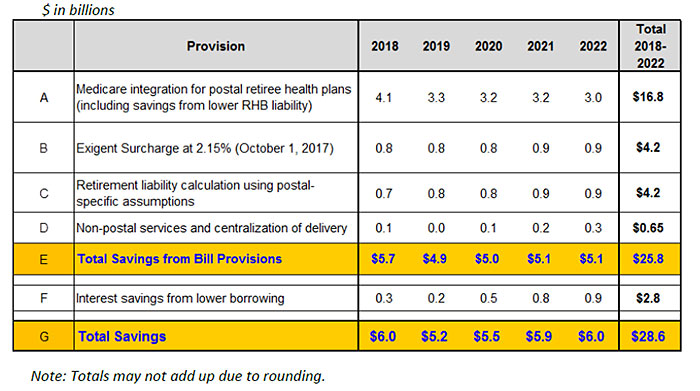
Note: Totals may not add up due to rounding.
Overall, our financial situation is very serious but solvable; we can return to financial stability through the enactment of prudent legislative reform that this Committee has introduced and a favorable resolution of the PRC’s 10-year pricing system review. At the same time, we will continue to pursue cost savings in all aspects of our operations and revenue growth. These steps will allow appropriate investment in the future of the organization, so that we can continue to provide prompt, reliable and efficient delivery service to the American public.
The mailing industry continues to help power our nation’s economy. The Postal Service plays an indispensable role as a driver of commerce and a provider of delivery services to all communities — and we fulfill this role by leveraging one of the nation’s oldest and most effective partnerships with the private sector. More than 18,500 small businesses help us serve the American public through mail processing, transportation and retail operations contracts. More than 14,000 postal transportation supplier contracts account for approximately $7 billion in annual spend. And we provide access to our products and services in more than 72,000 commercial locations through partnerships with retailers of all sizes.
The need to adopt the proposed legislative reform provisions discussed above is simply too important to delay. Indeed, Congressional action on legislative reform is more important than ever considering the onset of the PRC’s 10-year pricing system review. Ultimately, postal law requires the Postal Service to provide universal postal services, and to meet our other statutory obligations, in a self-sufficient manner, without becoming a burden on the taxpayer.
GOVERNANCE
We appreciate that the bill recognizes the importance of independent governance for the Postal Service. As an independent establishment within the Executive Branch, the Postal Service’s powers are directed by a Board of Governors, who serve as the equivalent of the outside directors on a private sector board of directors.
The Postal Service is currently operating without any Governors. The final outside Governor vacated his seat in December 2016, after serving a 1-year hold-over term past the expiration of his original term. The Senate has not confirmed a single Governor nominee since 2010.
The Governors select the Postmaster General and the Deputy Postmaster General and provide strategic oversight by approving overall expenditures (including our capital investment plan), reviewing practices, conducting long-range planning, and setting price and product policy, in accordance with postal statutes. These are essential oversight and decision-making functions that are best performed as the result of informed discussions among well-qualified Governors with diverse perspectives who can represent the public interest. The presence of the Governors, and their ultimate control and authority over the Postal Service, also ensures that the Postal Service’s governance structure adheres to constitutional requirements.
The Postal Service continues day-to-day operations and will do so for the immediate future, but our long-term success would be significantly enhanced in all respects with a fully constituted Board of Governors. The absence of Governors also raises significant legal questions that could materially impede the Postal Service’s continued ability to operate, and heightens the need to shore up our financial condition through legislation until Governors can be nominated and confirmed.
CONCLUSION
Mr. Chairman, the United States Postal Service delivers for the American public — both literally and figuratively. We serve every American business and residence. We do so reliably and affordably, and we strive continually to earn the trust of the American public by maintaining the privacy and security of the items we deliver. We enable America’s commerce by meeting its marketing and communications needs, by delivering the physical content that powers e-commerce, and by serving as an indispensable business partner to America’s entrepreneurs and business owners.
America deserves a financially stable Postal Service that can continue to play this vital role in our economy and society. In a dynamic and increasingly digital, mobile- and device-driven world, the Postal Service has opportunities to enhance the way we enable commerce. However, we require the financial ability to invest in the Postal Service’s future.
There is a path forward that depends upon the passage of provisions in H.R. 756, combined with a favorable outcome of the PRC’s 10-year pricing system review. Once enacted, and together with aggressive management actions, the Postal Service can meet all of our obligations and continue to improve the way we serve the American public.
Thank you, Mr. Chairman, Ranking Member Cummings and Members of the Committee, for the opportunity to submit this testimony. I welcome any questions that you and the committee may have.
###
